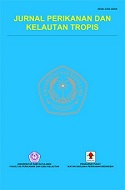Testing Frozen Tuna Histamine As Raw Material For Canned Fish In Pt. Sinar Pure Foods International Bitung City
DOI:
https://doi.org/10.35800/jpkt.v11i3.44591Kata Kunci:
Tuna; Histamine; CanningAbstrak
Bitung City is known as an industrial city, one of the fishing industries that is currently developing. There is a canned fish industry using tuna as raw material, which is export-oriented because the market potential of canned tuna is so large and spread in various countries in the world, becoming an export opportunity for canned tuna exporters in Indonesia, especially the canned tuna industry in Bitung city. Considering that developed countries are very sensitive in terms of the quality and safety of their products, so that the standards set are often not in line with some industries, so that it can lead to rejection of Indonesian fishery products in importing countries. The purpose of this study was to determine the histamine content in canned tuna raw materials at PT. Sinar Pure Foods International. Histmain value values from 2 samples of yellowfin tuna (Thunnus allbacares), and 1 sample of bigeye tuna (Thunnus obeseus) after passing the histamine testing process. Bigeye tuna (Thunnus obesus) with a size of 1kg, on the tail (RA), abdomen (RB), and head (RC) did not exceed 4ppm. The highest histamine content in the 1 kg large eye tuna (Thunnus obesus) sample was located in the abdomen (RB). While the lowest histamine content is located in the tail (RA). This proves that the fastest increase in histamine occurs in the stomach area (RB) which results can be considered very low because it is in the range of numbers below 4 ppm. yellowfin tuna (Thunnus Allbacares) with a size of 1.4 kg, on the tail (MA), stomach (MB), and head (MC) did not exceed 4ppm. The highest histamine content in yellowfin tuna (Thunnus Allbacares) samples measuring 1.4 kg was located in the abdomen (MB). While the lowest histamine content is located in the tail (MA). This proves that the fastest increase in histamine occurred in the abdominal area (MB) of 1.4 kg yellowfin tuna. yellowfin tuna (Thunnus Allbacares) with a size of 1.8 kg, on the tail (EA), stomach (EB), and head (EC) did not exceed 4ppm. The highest histamine content in yellowfin tuna (Thunnus Allbacares) samples measuring 1.8 kg was located in the abdomen (EB). While the lowest histamine content is located in the tail (EA). This proves that the fastest increase in histamine occurred in the abdominal area (EB) of 1.8 kg yellowfin tuna. This is in line with the standards set at the company, the standard for frozen tuna raw materials is 30 ppm and for canned fish 50 ppm, the increase in histamine content of the 3 samples studied, namely bigeye tuna 1kg, yellowfin tuna 1.4kg, and 1.8 kg yellowfin tuna has the same pattern, namely, histmin content is very easily formed in the belly of the fish
Keywords: Tuna, Histamine, Canning
Abstrak
Kota Bitung dikenal sebagai kota industri salah satu industri perikanan yang saat ini sedang berkembang. Terdapat industri ikan kaleng menggunakan bahan baku ikan tuna, yang berorientasi pada ekspor karena potensi pasar ikan tuna kaleng yang begitu besar dan tersebar di berbagai negara di dunia menjadi sebuah peluang ekspor bagi eksportir ikan tuna kaleng di Indonesia khususnya industri ikan tuna kaleng di kota Bitung. Mengingat negara maju sangat peka dalam hal mutu dan keamanan produknya, sehingga standar yang ditetapkan sering tidak sejalan dengan beberapa industri, sehingga dapat menyebabkan penolakan produk perikanan Indonesia di negara importir. Tujuan penelitian ini untuk mengetahui kandungan histamin pada bahan baku ikan tuna kaleng di PT. Sinar Pure Foods International. Nilai kadar histmain dari 2 sampel ikan tuna madidihang (Thunnus allbacares), dan 1 sampel ikan tuna mata besar (Thunnus obeseus) setelah melewati proses pengujian histamin. Tuna mata besar (Thunnus obesus) dengan ukuran 1kg, pada bagian ekor (RA), perut (RB), dan kepala (RC) tidak melewati 4ppm. Kandungan histamin tertinggi pada sampel ikan tuna mata besar (Thunnus obesus) ukuran 1kg terletak pada bagian perut (RB). Sedangkan kandungan histamin terendah terletak pada bagian ekor (RA). Hal ini membuktikan bahwa kenaikan histamin paling cepat terjadi pada area perut (RB) hasil yang di dapat terbilang sangat rendah karna berada di kisaran angka dibawah 4 ppm. tuna madidihang (Thunnus Allbacares) dengan ukuran 1,4kg, pada bagian ekor (MA), perut (MB), dan kepala (MC) tidak melewati 4ppm. Kandungan histamin tertinggi pada sampel ikan tuna madidihang (Thunnus Allbacares) ukuran 1,4kg terletak pada bagian perut (MB). Sedangkan kandungan histamin terendah terletak pada bagian ekor (MA). Hal ini membuktikan bahwa kenaikan histamin paling cepat terjadi pada area perut (MB) dari ikan tuna madidihang ukuran 1,4kg. tuna madidihang (Thunnus Allbacares) dengan ukuran 1,8kg, pada bagian ekor (EA), perut (EB), dan kepala (EC) tidak melewati 4ppm. Kandungan histamin tertinggi pada sampel ikan tuna madidihang (Thunnus Allbacares) ukuran 1,8kg terletak pada bagian perut (EB). Sedangkan kandungan histamin terendah terletak pada bagian ekor (EA). Hal ini membuktikan bahwa kenaikan histamin paling cepat terjadi pada area perut (EB) dari ikan tuna madidihang ukuran 1,8kg. Hal ini sejalan dengan standar yang di tetapkan pada perusahan tersebut, standar untuk bahan baku ikan tuna frozen 30 ppm dan untuk ikan kaleng 50 ppm, kenaikan kandungan histamin dari 3 sampel yang di teliti yaitu tuna mata besar 1kg, tuna madidihang 1,4kg, dan tuna madidihang 1,8kg memiliki pola yang sama yaitu, kandungan histmin sangat mudah terbentuk pada bagian perut ikan.
Kata Kunci : Ikan Tuna, Histamin, Pengalengan
Referensi
EC, 2005. (2005). [EC] European Commission. (2005). Regulation (EC) No.2073/2005 of 15 November 2005 on microbiological criteria for foodstuffs. Official Journal of the European Union
Evangelista, W. P., Silva, T. M., Guidi, L. R., Tette, P. A. S., Byrro, R. M. D., Santiago-Silva, P., Fernandes, C., & Gloria, M. B. A. (2016). Quality assurance of histamine analysis in fresh and canned fish. Food Chemistry
FAO. (2012). [FAO] Food Agricultural Organization of the United Nations. (2012). Codex alimentarius Commission. Joint FAO/WHO Food standar programme. Codex committee on fish and fishery products, 32 session discussion paper histamine, 1-14. Food Agricultural Organization of the United Nations
FAO Food and Agriculture Organization. (2019). Globefish Higlights: A Quaterly Update on World Seafood Markets. In FAO
FDA. (2011). Fish and Fishery Products Hazards and Controls Guidance. Fish and Fishery Products Hazard and Control Guidance Fourth Edition, April, 1–401.
FDA U.S. Food and Drug Administration. (2019). Fish and Fishery Products Hazards and Controls Guidance - Fourth Edition. In Fish and Fishery Products Hazard and Control Guidance Fourth Edition.
Hansamali, L. H. D., Ranatunga, R. R. M. K. P., Buddhinie, P. K. C., & Ashoka, P. (2020). Determination of shelf life of Tuna sirip kuning (Thunnus albacares) with regard to microbial count, histamine level and flesh colour. Sri Lanka Journal of Aquatic Sciences, 25 (1), 1–8.
Irawati, H., Kusnandar, F., & D Kusumaningrum, H. (2019). Analisis Penyebab Penolakan Produk Perikanan Indonesia oleh Uni EropaPeriode 2007-2017 dengan Pendekatan Root Cause Analysis. Jurnal Standardisasi, 21(2), 149.
Jinadasa, B. K. K. K., Galhena, C. K., & Liyanage, N. P. P. (2015). Histamine formation and the freshness of Tuna sirip kuning (Thunnus albacares) stored at different temperatures. Cogent Food & Agriculture,
Maulana, H., Afrianto, E., &Rustikawati, I. (2012). Analisis bahaya dan penentuan titik pengendalian kritis pada penanganan tuna segar utuh di PT. Bali Ocean Anugrah Linger Indonesia Benoa-Bali. Jurnal Perikanan Kelautan, 3(4), 1–5.
Sutrisno Sompie (2017) Kajian aspekteknis unit penangkapankapalpole and line yang berpangkalan di Pelabuhan Perikanan Samudera Bitung. Jurnal Ilmu dan Teknologi Perikanan Tangkap
Tahmouzi, S., Ghasemlou, M., Aliabadi, F. S., Shahraz, F., Hosseini, H., & Khaksar, R. (2013). Histamine formation and bacteriological quality in skipjack tuna (Katsuwonus pelamis): Effect of defrosting temperature. Journal of Food Processing and Preservation,
Tuerah, N. (2019). Bunga RampaiRekomendasiKebijakan, Edisi 2. Jakarta: Penerbit Badan KebijakanFiskal Kementerian KeuanganRepublik Indonesia.
Umboh, C. C., Kindangen, P., Wulur, M., Jaringan, D., Rantai, M., Industri, P., & Tuna, I. (2020). Desain Jaringan Manajemen Rantai Pasok Industri Ikan Tuna Kaleng Di Kota Bitung. Jurnal EMBA: Jurnal Riset Ekonomi, Manajemen, Bisnis Dan Akuntansi, 8(3), 372–378.
Umboh, C. C., Kindangen, P., Wulur, M., Jaringan, D., Rantai, M., Industri, P., & Tuna, I. (2020). Desain Jaringan Manajemen Rantai Pasok Industri Ikan Tuna Kaleng Di Kota Bitung. Jurnal EMBA: Jurnal Riset Ekonomi, Manajemen, Bisnis Dan Akuntansi, 8(3), 372–378.
Unduhan
Diterbitkan
Cara Mengutip
Terbitan
Bagian
Lisensi
Hak Cipta (c) 2022 Rizky Ryan Wengke, Feny Mentang, Albert Royke Reo, Hens Onibala, Nurmeilita Taher, Jenki Pongoh

Artikel ini berlisensi Creative Commons Attribution-NonCommercial 4.0 International License.











